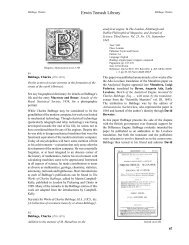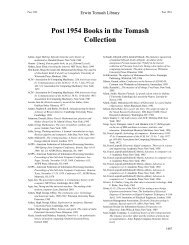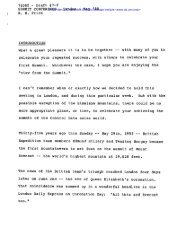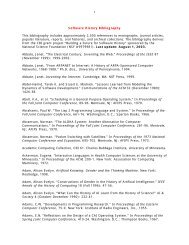M chapter.indd - Charles Babbage Institute
M chapter.indd - Charles Babbage Institute
M chapter.indd - Charles Babbage Institute
Create successful ePaper yourself
Turn your PDF publications into a flip-book with our unique Google optimized e-Paper software.
860<br />
Erwin Tomash Library<br />
Maurer, Paul Jean Baptiste Maxwell, James Clerk<br />
This is an advertising brochure created by the firm of<br />
Maurel and Jayet for their multiplication machine. The<br />
first part consists of a reprint of a report recommending<br />
the machine to the French Academy. This is followed<br />
by reprints of glowing testimonials from the press and<br />
private citizens.<br />
The Arithmaurel was designed especially to do<br />
multiplication. As the drawing on the front cover<br />
indicates, a multiplicand of up to eight digits is set on<br />
the uppermost bars extending from the front of the<br />
machine. Four lower keys (one for units and others for<br />
tens, hundreds and thousands) are then turned to enter<br />
the multiplier. Answers may be read from the lower set<br />
of result dials while an upper set keeps a running total of<br />
the series of multiplications.<br />
The machine was not popular, and today only a few<br />
examples survive in the collections of the Conservatoire<br />
des Arts et Métiers and in private hands.<br />
Illustrations available:<br />
Cover page<br />
M 69<br />
Maurer, Paul Jean Baptiste (1885–)<br />
M 68<br />
Machines automatiques méchaniques et électiques<br />
Year: 1934<br />
Place: Paris<br />
Publisher: Armand Colin<br />
Edition: 1st<br />
Language: French<br />
Figures: 42 figures in text<br />
Binding: original paper boards<br />
Pagination: pp. [2], 185, [3], 12<br />
Size: 160x99 mm<br />
The author was a professor at the School of Electrical<br />
and Mechanical Engineering in Paris.<br />
This small volume surveys automatic machines of many<br />
different types. It begins with simple devices such as<br />
lathe followers and ends with discussions of linotype<br />
machines and devices for automatically making light<br />
bulbs and a short section on calculating machines.<br />
Illustrations available:<br />
Title page<br />
M 70<br />
Maxwell, James Clerk (1831–1879)<br />
M 69<br />
On governors. In Proceedings of the Royal Society of<br />
London, Vol. XVI.<br />
Year: 1868<br />
Place: London<br />
Publisher: Taylor & Francis<br />
Edition: 1st<br />
Language: English<br />
Binding: purple buckram over boards; spine worn<br />
Pagination: pp. xii, 534, lxxxii, pp. 270–283<br />
Collation: π 6 B–E 8 F 4 G–L 8 M 1 N 4 O 1 P 8 Q 1 R 2 S 1 T–U 8 X 4 Y 8 Z 2<br />
2A 8 2B 2 2C–2D 8 2E 4 2F 2 2G 8 2H 4 2I 1 2K–2X 8 2Y 2 b–e 8 f 3 g 4 h 2<br />
Size: 211x132 mm<br />
Maxwell was born in Edinburgh and was educated at<br />
Edinburgh Academy before going on to Cambridge.<br />
His remarkable mathematical and scientific aptitude<br />
was evident even as a boy. At the age of fourteen, he<br />
read his first paper, On the description of oval curves<br />
… to the Royal Society of Edinburgh. He is, of course,<br />
best known for his work on electricity, magnetism and<br />
the electromagnetic theory of light. He was, however,<br />
interested in many other branches of physics and<br />
mathematics. Maxwell taught in Cambridge and Aberdeen







